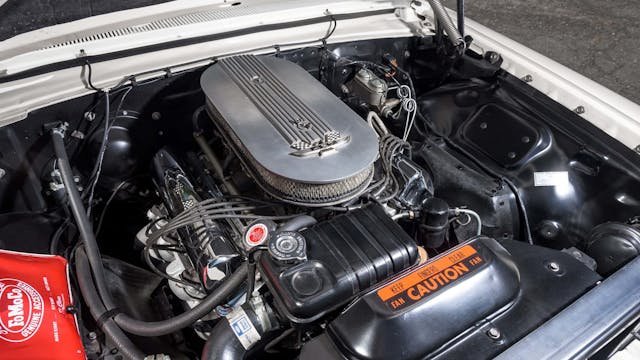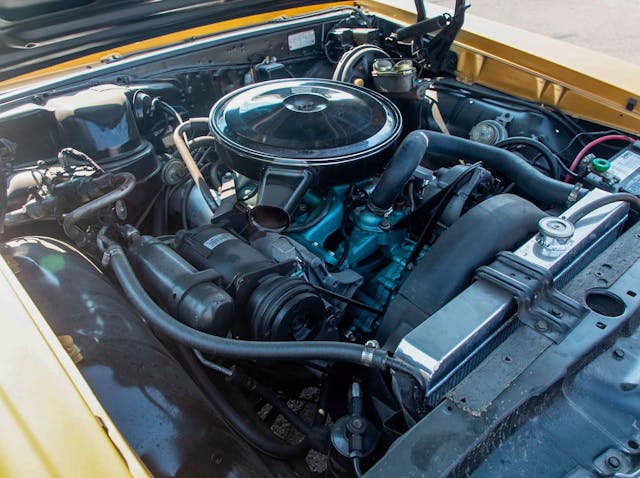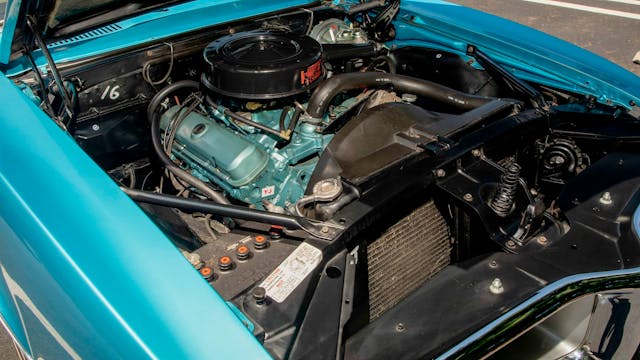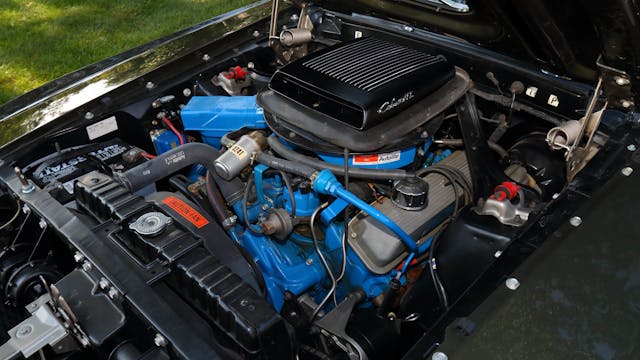5 famous V-8s whose displacements stretched the truth
We know that the 1960s were full of horsepower hijinks, but did you know that manufacturers sometimes fibbed about the size of their engines? Indeed, that burbling V-8 in your beloved classic may actually not measure up to its promised displacement. We rooted out five of the worst offenders.
Ford/Mercury 427

Available from mid-1963 to mid-1968, the 427 was Ford’s crowning achievement in the 1960s, carrying the torch during Ford’s “Total Performance” reign of global competition. However, to American enthusiasts, the 427 is best known for powering Fords and Mercurys to success on the drag strip and in NASCAR. The FE-series engine was introduced at the same time as Ford’s semi-fastback roofline for the Galaxie 500 and Galaxie 500/XL (as well as Mercury’s Marauder sub-series), and the silhouette’s aerodynamic advantages helped maximize the engine’s performance on the banked ovals. The street 427 was available with either a single or pair of four-barrel carburetors for 410 or 425 horsepower, respectively. Several thousand 427s were built through 1964, with popularity falling drastically in 1965, the last year of big Mercury; in its swan-song year of 1967, the 427 was installed in 89 full-size Fords.

Even with pressure from the GTO and Chrysler’s Hemi, Ford produced only 57 1966 Fairlane 500 hardtops carrying the 427, which were joined by a nominal 229 Fairlanes and 60 Comets and Cyclones in 1967. The very last 427 produced was the 1968 Cougar GT-E (detuned with hydraulic lifters and a four-barrel for 390 hp); after the ’68 model year, it was replaced by the 428 Cobra Jet.
The 427’s bore and stroke was 4.232 x 3.784 inches. Plug that into your engine-displacement calculator and you’ll get 425.816 cubic inches. Since Chrysler already had a 426, did Ford want to advertise a superior size?
Pontiac 428

As far as the bigger Pontiac engines are concerned, the 428 is somewhat lost between the 421 from Pontiac’s racing heyday and the massive 455. However, from 1967–69, the 428 was the top engine for Pontiac’s full-size series. Initial power output was 360 hp or, in High Output (HO) configuration, 376. For 1968, those ratings were bumped to 375 and 390 hp, respectively. For 1969 a lesser, 360-horse version became standard for the Bonneville, though HO was still optional for all full-size Pontiacs. The 428 also was available for the downsized 1969 Grand Prix, with a 370-horse iteration standard with the SJ package and the HO optional for both the J and SJ. The latter made for a personal-luxury car that was faster than some GTOs.
Alas, the 428 wasn’t quite what it seemed. When you account for the 4.12-inch bore and 4.0-inch stroke, actual displacement comes out to 426.613 cubic inches.
Ford/Mercury 428

A member of the FE engine series like the 427, the 428 debuted for the 1966 model year. Unlike the 427, the 428 was designed to deliver smooth, streetable power—it was rated at 345 hp. Though available for all full-size Ford and Mercury models, it was showcased in the Galaxie 7-Litre and S-55. The 428 continued to be available through 1968, though it was available through 1970 in 360-horse Police Interceptor form. The 1967–68 Shelby GT500 also used the PI 428.
Of course, the 428 is most famous for the Cobra Jet variant that debuted at the 1968 Winternationals and hit the streets in April of that year. It was rated at 335 horsepower but was actually was more powerful than both the regular and the PI 428. Though available for FoMoCo’s pony cars and mid-sizers in 1968, the 428 Cobra Jet was discontinued for mid-size cars in 1970 and pony cars in ’71.
The 428’s bore and stroke measured 4.132 x 3.984 inches, which equals 427.386 cubic inches. Yes, you read that right—the 428 is a 427! Because Ford already had a 427 of sorts, the folks at Dearborn simply rounded up.
Pontiac 350

Pontiac’s 5.7 often gets lost in the shuffle, even though it was produced well into the 1970s. The 350 was Pontiac’s bread-and-butter option for mid-size vehicles and Firebirds starting in 1968 (it replaced the 326), but the High Output variant was overshadowed by the GTO and Firebird 400. The 350 HO was rated at 320 horsepower and available in the Firebird HO plus any A-body coupe, convertible, or sedan. For 1969, horsepower jumped to 325 horses for the Firebird HO and 330 for A-bodies. This was the same engine that had been planned for the stillborn Tempest-based “ET” that evolved into the GTO Judge.
Even so, a 3.875-inch bore and 3.746-inch stroke doesn’t equal 350 cubic inches. In fact, it yields 353.42.
Pontiac 326

None of the above engines have the twisted history of Pontiac’s 326. First appearing in 1963, the 326 featured a bore and stroke of 3.781 x 3.746 inches, which equals 336.481 cubic inches. What gives, Pontiac?
Starting in 1955, small GMC trucks with gasoline V-8s began using Pontiac engines. For 1958, GMC took Pontiac’s 370 block and gave it a 3.875 x 3.5625 bore and stroke for a total of 336.107 cubic inches. The following year, GMC took the new 389 and recreated the 336 with new dimensions. An evolution of this engine was made an option for the 1963 Tempest series as a replacement for Buick’s aluminum 215 V-8: two-barrel variants made 250 or 260 hp, depending on compression ratio, and the four-barrel High Output version made 280. But you’ve probably heard the folklore about cubic-inch edicts at General Motors at the time; for smaller cars, that limit was 330 cubic inches. As such, Pontiac called the 336 a 326. According to Pontiac historian Don Keefe, corporate brass caught wind of the transgression and made Pontiac correct the issue. Therefore, from 1964–67, the 326 featured a 3.71875 bore for a more politically correct final displacement.
Know of any other engines that don’t live up to their advertised displacements? Tell us about them!



IN 1972 AFTER A TRIP TO ALASKA WITH MY 1969 FORD F-250 WITH A 10 FT TRUCK CAMPER, THE 352 ENGINE WAS VERY TIRED. I WENT TO THE LOCAL WRECKING YARD AND BOUGHT A 428 CJ OUT OF A WRECKED MERCURY. THE SWAP WAS EASY AND HEADERS AND MUFFLERS WERE INSTALLED. THE PERFORMANCE WAS GREAT. WITH CAMPER AND 22′ SALMON BOAT I COULD PASS ABOUT ANYTHING ON THE ROAD – EXCEPT GAS STATIONS.
Those dad stories are funny. Mine bought me a 67 Plymouth 440, He said “It’s got dual exhausts, so be careful.”
It’s way worse in motorcycle displacement. Vintage Honda 350 is about 326 cc I think. Everything was 250, 350, 400 etc, but the engines were anything but.
“the 326 featured a 3.71875 bore” I’m s sure you could just run right down to the machine shop in the mid 1960’s and they would be more than happy to hit that number on a production line, as long as the tolerance was ±.003 maybe. Exact numbers are nice but numbers in the X.XXX range are far more realistic.
Interesting, but not overly important. The little variances would not have affected performance much at all. Pure advertising hype.
Cleveland’s we’re boat anchors. Windsors we’re most sought after.
Another instance when Detroit just cannot be trusted. Oh the pain and anquish this has caused.
The very first car my wife bought right out of high school was a 4 door Pontiac Tempest Custom with the 326. She really fooled a lot of people at the stoplight when she pushed down on the throttle. I can still remember the time she gave me my first ride in it!!!!!!!!!!! Married her four years later and we are still together. Sadly, though, the Tempest has been long gone. She still has her 1985 Fiero GT V6 with 4-speed tranny. Looks like in new condition.
There is no replacement for Cubic inch Displacement !
Buick used to advertise their Torque on the 401 & 425 engines as 445 and 465 respectively.
The Pontiac 326 was released displacing 336 in 1963. However, GM came out with a rule that the maximum displacement for any A body car would be 330 cubic inches. To accommodate, Pontiac decreased the bore to 3.72″ in 1964 to yield a 326.1 cubic inch motor.
I am surprised that perhaps the most famous of all is not listed, the original 5.0. Yes, it was a 302, and yes, it was known as a 302 previously, but when Ford started using the 5.0 moniker, it was exaggerating. Several magazines in the 80’s didn’t directly call out them, but in the specs list, they listed the engine’s displacement as “4.9L.”
I had a 1964 Pontiac Lemans with a 326 and 3 on the floor that you could wind out to 80 mph in 2nd gear. Absolutely loved that car!